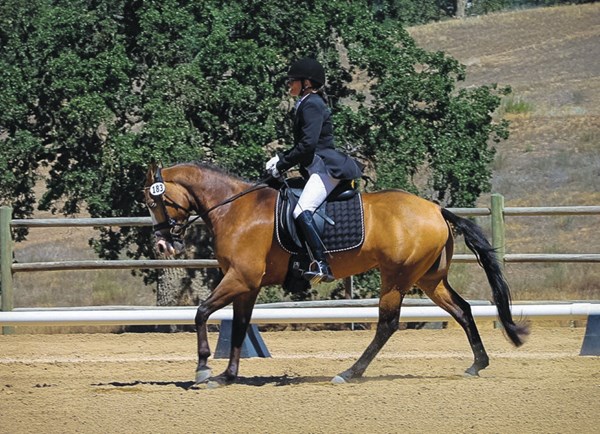
The picture shows Wendy Malek on her 5-year-old Azteca mare, Bloo. Wendy wrote that Bloo had been a rescue horse as a yearling and has now turned into a wonderful partner for her. They are showing Training Level and are schooling First Level, just starting to work on lengthenings. This picture was taken at their second show, and Wendy said that her biggest challenge right now is to keep Bloo from curling behind the bit.
At the moment this photo was taken, Bloo is in the landing phase of the left-canter stride, and one can see that she is reaching with her hind leg well under the rider’s weight. Her shoulders appear a little heavy. Specifically, her inside shoulder and front leg appear a little tense and not reaching out as free and forward as I would like to see in this phase of the canter stride. Bloo’s nose-line is a bit behind the vertical. The expression on her face is not relaxed and I also notice more tension in her lower neck muscles, with her slightly open mouth and her ears a bit too far back for her to be considered relaxed and concentrated, listening to the rider.
I can tell that Wendy wants to follow her horse’s movement and is attempting to sit lightly. But her seat does reveal some tension and discomfort: her hips are tight and this causes her lower legs to turn too far outside, preventing a springy elasticity from her hips to her heels during the canter stride. Looking at her left hand, I notice that her wrist is curled inward and her hand is positioned farther back than what is ideal.
In this phase of the canter stride, Bloo needs to open and stretch her neck more forward. In walk and canter, the horse’s neck has a natural forward-nodding movement, which the rider’s hands need to follow. If you watch racehorses in action, the jockeys’ hands perform a forward movement, known as “strapping,” to encourage the horse to reach out further with the front legs and cover more ground, especially across the finish line.
To understand how much the hand movement of the rider is connected to the freedom of the horse’s shoulders, try this: In canter, take up a comfortable forward position or jumping seat. Place your hands in the middle of your horse’s neck (between the horse’s ears and the saddle) and keep them there during the canter strides. Your hands should not move and should maintain an even pressure or weight on your horse’s neck. To be able to do this, you will notice that your elbows and shoulders need to allow for more movement in every canter stride. You should be able to clearly feel that you need forward freedom in your arms that begins in your shoulders and continues down through the slight stretching of your elbows when your horse reaches out with his forehand. When you return to your dressage seat, you should still be able to feel this same sensation even if it becomes less visible.An image that helps to illustrate this is to think of the rider and horse each as a ball stacked one on top of the other, with the rider as a slightly smaller ball.
If Wendy can imagine herself being the top ball on top of a round canter stride, she will find it easier to sit deeper and lengthen her back. This will allow her pelvis to relax and follow the horse’s back movement better. Her hips then can become more free. With a more stable and balanced seat, she will then be able to give her inside hand forward during the canter stride and this will allow Bloo to reach out more with her shoulder and carry her nose farther in front.
For another helpful exercise, try this: Close your eyes for a few canter strides, concentrating fully on the amount of contact you feel in your hands. This contact should remain steady and equal during the whole stride, including the takeoff and landing. This is only possible when you perform a forward movement with your hands. If your hand stays fixed in place, your horse will, in every landing, jump into the rein. Wendy will most likely feel this as a stronger contact, and this will shorten Bloos’ stride, especially when she hits the contact with the inside rein, which can cause her to curl up more. This tendency will also become more exaggerated in the lengthenings.
I hope that these tips will help Wendy deepen her partnership with her nice young horse.











